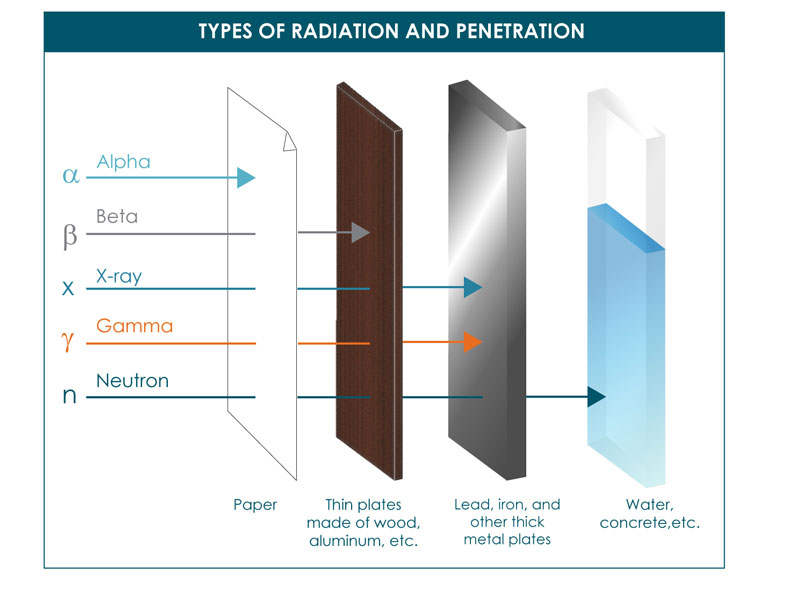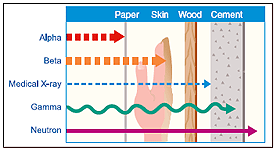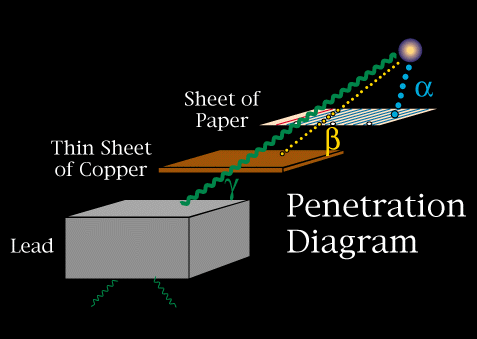Describe the Penetrating Power of Each Common Type of Radiation
Gamma rays are a radiation hazard for the entire body. Alpha particles can be blocked by a few pieces of paper.
Shielding with dense materials like concrete and lead is used to avoid exposing sensitive internal organs or the people who may be working with this type of radiation.

. Penetrating power refers to the energy with which the radiation particles are ejected from the atom. Gamma rays are the most difficult to stop and require concrete lead or other heavy shielding to block them. Beta particles pass through paper but can be stopped by metal foil.
3 mm aluminium foil. Gamma rays have the most energy and can penetrate substances up to a few centimetres of lead or a few metres of concrete. Thick sheet of paper.
Beta radiation has more penetrating power than alpha radiation and can be absorbed by a few centimeter of aluminium sheet. The table below summarizes the main types of nuclear radiation including charge mass symbol and penetrating power. Gamma y Second highest.
At least 40 mm lead or 2. Beta - these are fast moving electrons. In general the greater mass present the greater the ionizing power and the lower the penetration power.
The penetrating power of alpha rays beta rays and gamma rays varies greatly. Penetration of Gamma rays Gamma rays are the most penetrating of the radiations. There are three types of radiation these are alpha beta and gamma radiations.
No actual particles are involved but a very high energy wave that. Alpha radiation has the lowest penetrating power and can be easily stopped by a thin sheet of paper. Penetration of the modes of decay Alpha particles can be completely stopped by a sheet of paper.
Most alpha particles can be stopped by a sheet of paper or by clothing. Gamma rays and x-rays can penetrate through the body. A piece of paper or the dead outer.
There are three primary types of radiation. Gamma rays are the most penetrating type of radiation and represent the major external hazard. Gamma rays have so much penetrating power that several inches of a dense material like lead or even a few feet of concrete may be required to stop them.
Beta particles pass through paper but can be stopped by metal foil. Penetrating power refers to the relative ability of the radiation to pass through common materials. Alpha particles are the least penetrating.
Alpha particles cannot penetrate most matter. The higher the energy the more the particles or light produced by radioactive decay will penetrate a substance. Beta radiation is more penetrating than alpha radiation.
This is why they are useful in medicineto show whether bones are broken or where there is tooth decay or to locate a tumor. Penetrating Powers of Ionizing Radiation Teacher Answer Key 1. It cannot be said that a particular thickness of a material can absorb all gamma radiation.
The relative penetrating abilities of alpha beta and gamma radiation. Gamma Radiation produces the most penetrating form of radiation. It can pass through the skin but it is absorbed by a few centimetres of body tissue or a few.
Radiation with high penetrating power is potentially more dangerous because it can pass through skin and do cellular damage. Few mm of aluminium sheet to some extent A couple of cm of a block of lead. Though the least ionising of all the forms of radiation that doesnt mean Gamma rays arent dangerous.
Speed of light Relative ionisation power. Describe the penetrating power of each common type of radiation. Beta particles can be stopped by a few millimetres of aluminium.
Beta particles pass through paper but are stopped by aluminum foil. Most alpha particles can be stopped by a sheet of paper or by clothing. Gamma rays or gamma radiation Electromagnetic radiation of high energy.
Beta plus and minus decay particles are more penetrating than alpha decay as they are higher in energy and have a smaller mass size a high energy electron minus decay or a high energy positron plus decay. Gamma rays which are much more penetrating can pass through several meters of concrete. They can easily penetrate barriers that can stop alpha and beta particles such as skin and clothing.
The more material the radiation can pass through the greater the penetration power and the more dangerous it is. Alpha particles are the least penetrating. 424 know the general formula for alkenes.
Alpha particle has the least penetrating power beta. Even with such intense barriers some radiation may still get through because of how small the rays are. They have high energy typically in the MeV range but due to their large mass they are stopped by just a few inches of air or a piece of paper.
422 describe the reactions of alkanes with halogens in the presence of ultraviolet radiation limited to mono-substitution knowledge of reaction mechanisms is not required d Alkenes. 1 gray 100 rad Inverse square law. 423 know that alkenes contain the functional group CC.
Describe the penetrating power of each common type of radiation. The ability of each type of radiation to pass through matter is expressed in terms of penetration power. High 5 centimetre cm Beta.
Penetrating power Ionising power Range in air. 1 metre m Gamma. Geiger counter or G-M meter An instrument used to detect and measure radiation.
What has the least penetrating power gamma ray alpha particle or beta particle. Alpha - these are fast moving helium atoms. Beta B Weakest penetration.
Three types of radioation - Alpha Beta Gamma. Comparing only the. Encyclopædia Britannica Inc.
Gray The SI unit of absorbed dose. Hypothesize whether each has the ability to penetrate pass through your skin and body. Gamma rays are highly energetic waves and are poor at ionising other atoms or molecules.

Frequently Asked Questions Nrc Gov



No comments for "Describe the Penetrating Power of Each Common Type of Radiation"
Post a Comment